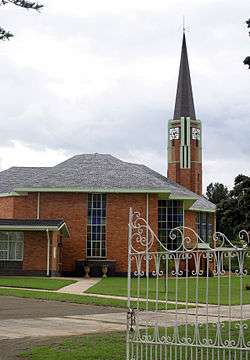Petrus Steyn
| Petrus Steyn | |
|---|---|
|
Petrus Steyn Church | |
 Petrus Steyn  Petrus Steyn  Petrus Steyn
| |
| Coordinates: 27°39′00″S 28°08′00″E / 27.65000°S 28.13333°ECoordinates: 27°39′00″S 28°08′00″E / 27.65000°S 28.13333°E | |
| Country | South Africa |
| Province | Free State |
| District | Thabo Mofutsanyane |
| Municipality | Nketoana |
| Established | 1912 |
| Area[1] | |
| • Total | 11.0 km2 (4.2 sq mi) |
| Elevation | 1,700 m (5,600 ft) |
| Population (2011)[1] | |
| • Total | 12,893 |
| • Density | 1,200/km2 (3,000/sq mi) |
| Racial makeup (2011)[1] | |
| • Black African | 95.7% |
| • Coloured | 0.3% |
| • Indian/Asian | 0.5% |
| • White | 3.4% |
| • Other | 0.1% |
| First languages (2011)[1] | |
| • Sotho | 83.2% |
| • Zulu | 7.4% |
| • Afrikaans | 4.6% |
| • Sign language | 2.0% |
| • Other | 2.8% |
| Postal code (street) | 9640 |
| PO box | 9640 |
| Area code | 058 |
Petrus Steyn is a small farming town between Tweeling and Kroonstad in the Free State province of South Africa.
Town 45km north-east of Lindley. Named after the owner of the farm on which it was laid out in 1914.[2]
Formerly known as Concordia, the town is the centre of an agricultural area known for wheat, maize, sunflower, potato, cattle and sheep production. The sandstone parsonage of the local Dutch Reformed Church was declared a national monument in 1988.[3]
References
- 1 2 3 4 Sum of the Main Places Petrus Steyn and Mamafubedu from Census 2011.
- ↑ "Dictionary of Southern African Place Names (Public Domain)". Human Science Research Council. p. 364.
- ↑ "Towns included in the Grasslands Meander". Grasslands Meander. Retrieved 29 August 2014.
This article is issued from Wikipedia - version of the 8/18/2016. The text is available under the Creative Commons Attribution/Share Alike but additional terms may apply for the media files.

.svg.png)